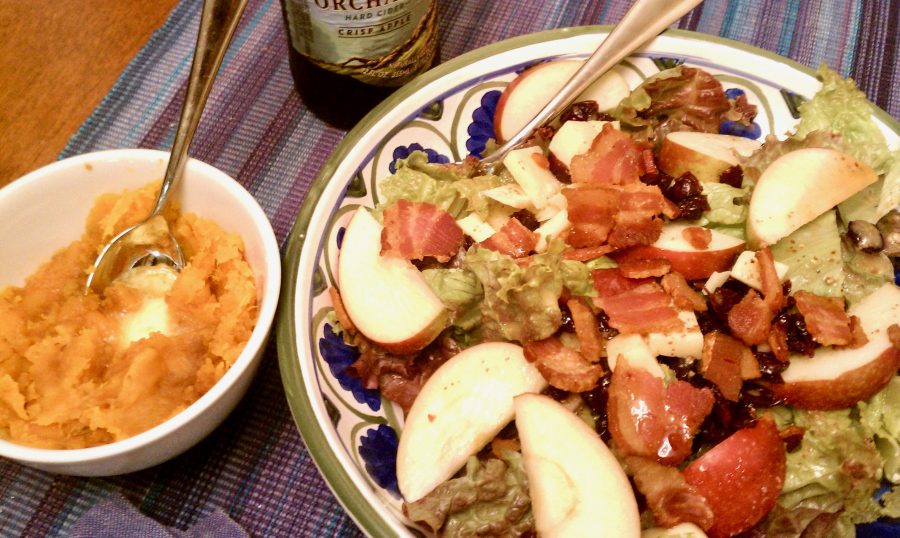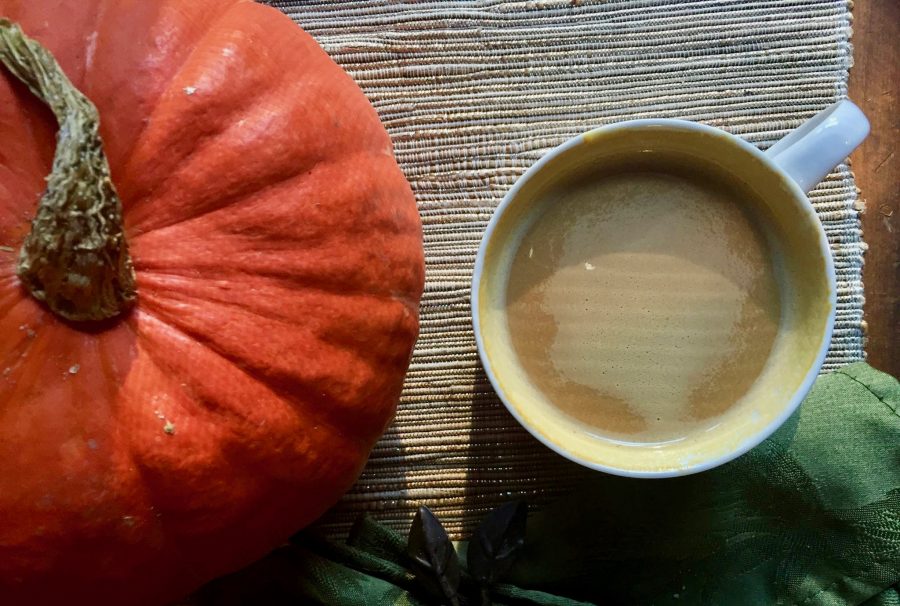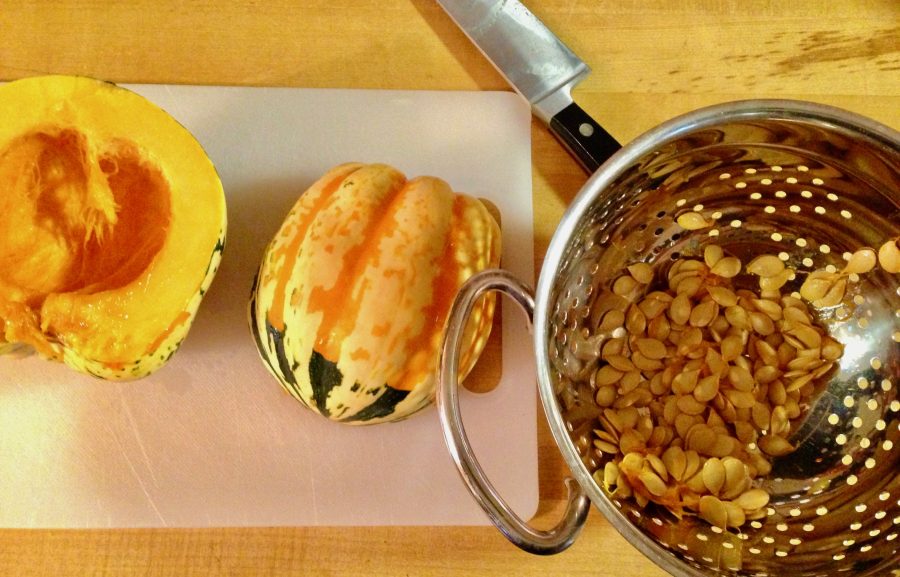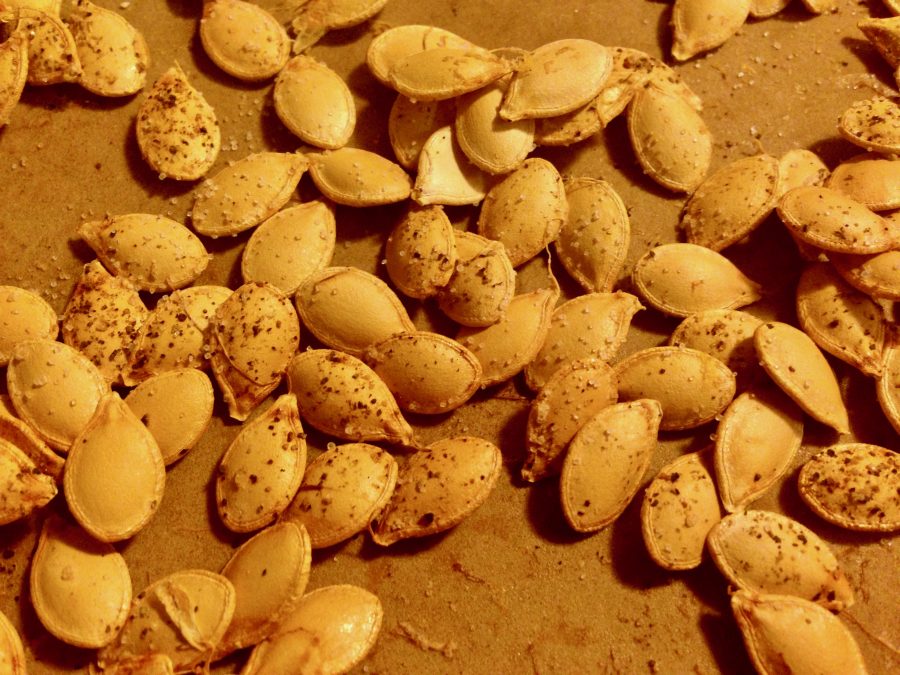Salads, I’m done with you. It’s time to turn up the oven.
Quick Links to Recipes:
- Roasted Squash #1 (flesh/puree)
- Ways To Use Roasted Squash Puree
- Roasted Squash #1 (cubes)
- Roasted Squash & Autumn Vegetable Medley
- Whipped Butternut Squash
- Butternut Squash and Sausage Soup with Crispy Sage
- Cheesy Squash Casserole
- Toasted Squash Seeds
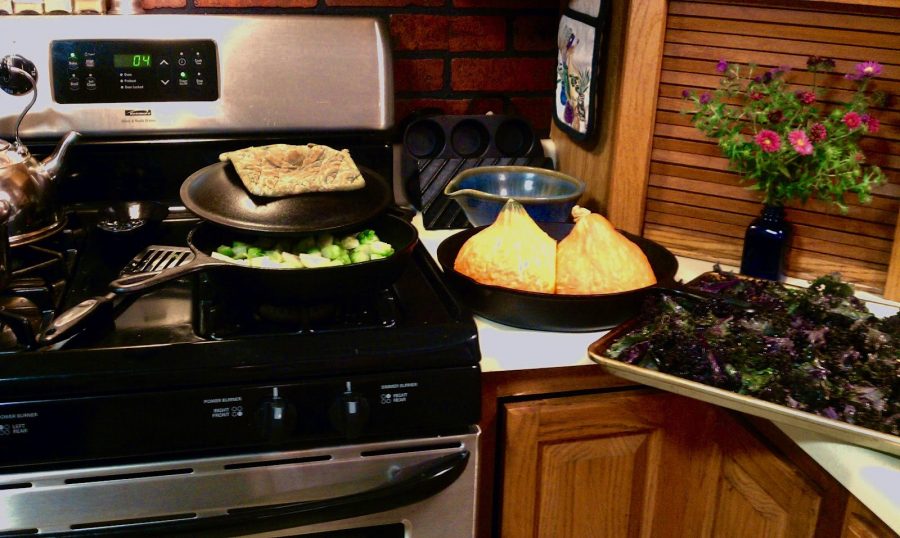
Pumpkins and winter squash belong to the Cucurbita genus. Only a few species of Cucurbita have been bred into a wide range of squashes across the world. The three most commonly sold squash species are…
- C. pepo includes summer squash (zucchini, yellow summer squash, pattypan), ornamental gourds, pumpkins, and winter squash (acorn squash, spaghetti squash).
- C. moschata includes butternut squash, the types of pumpkins often used to make canned pumpkin puree (including Libby’s), and many other lesser-known squash. They tend to be more tolerant of hot weather and resistant to squash borer.
- C. maxima represents another set of winter squash including kuri, kabocha, hubbard, buttercup, and other pumpkins. C. maxima tends to have bigger seeds than the C. pepo, which are not as tasty whole due to their tougher outer coat, but once mechanically hulled, make for nice pepita seeds (though all the species listed here have been sold as pumpkin or pepita seeds).
Red Kuri & Kabocha Squash – Move Over, Pumpkin Puree!
Back in my natural food store days, I fell in love with these deep orange pumpkin-ish winter squash. They give roasted pumpkin puree a run for its money, knocking it out of the park with with sweet, rich, full flavor akin to bread pudding. Deep orange, the cooked flesh makes a great sweet or savory side or ingredient in many autumn recipes from stew to warm, blended coffee. Dunkin Donuts, your “pumpkin spice” has nothing on this squash!
All winter squash will give you a boost of carotenoids including beta carotene, but the deeply hued red kuri and kabocha are *loaded* these pigments. Carotenoids have anti-cancer properties, support the immune system, eye health, protect the skin from sun damage (not that this is a hug concern in autumn), and support healthy lubrication and mucous membranes, such as the skin to protect us from the cold, dry season that lies ahead. Cooking them well and serving them with a wee bit of fat enhances the bioavailability and makes them taste vastly better.
Roasted Squash Recipe #1
This recipe can used for many different types of squash but suits red kuri and kabocha squash particularly well. This method roasts nearly-whole squash to scoop out the flesh and use as puree.
Cut in half, scoop out the seeds*, and bake cut-side-down at 420°F for about 40 minutes or until the flesh is fork-tender. Let cool a tad, then carefully scoop the flesh off of the skin. Use as is or puree in a blender to a smoother consistency. It freezes well for later use, too.
(*Most squash seeds can be picked clean, rinsed, and used to make toasted squash seeds – recipe below – but unfortunately kuri and kabocha squash have large, fibrous seeds that aren’t quite as enjoyable. Instead, you can feed the seeds to your chickens or toss them into a simmering soup stock to strain out before serving.)
Ways to Use Roasted Squash Flesh
(which are particularly amazing for red kuri and kabocha but also apply)
- Perfectly plain as a side dish – it’s that good, but even better…
- Piping hot with a dab of butter, drizzle of maple syrup, and sprinkle of cinnamon (as a side or for dessert)
- As a filling for “pumpkin” pie
- Added to chili and stews to provide sweetness, heft, and added nutrition
- Pureed with coconut milk and simmered with lemongrass for a Thai-inspired soup
- Fry some snipped, fresh sage leaves in a little butter or olive oil, then make an egg scramble with a local egg, scoop of leftover squash, and chunks of cheddar
- Use it to make “pumpkin” bread
- Blend with warm, creamy coffee (even herbal “coffee”) along with ¼ teaspoon vanilla extract and, if desired, pumpkin pie spices like a pinch of cinnamon, clove, and nutmeg
- Blend with chia seeds and coconut or oat milk, vanilla, pumpkin pie spices, and maple syrup to taste, let set, and enjoy warm or cold as chia pudding
Delicata, Dumping & Carnival Squash ~ The Zero-Waste Squash
These small, long, white-green-yellow-orange striped squash are among my favorites because you can eat *everything* and they are super easy to prepare (and super delicious to eat). Delicata is more oblong while carnival and dumpling are shaped like squat, little ornamental pumpkins. At their best, they’re slightly sweet with a hint of corn flavor, though a bit dryer in texture than the kuri and kabocha.
So, in case you didn’t catch it, you can eat the peels of these squash! Simply chop them up, toss with oil, and roast with seasoning of choice. I usually cube them, but you can get fancy pants and slice them crosswise into thin rounds for more wow factor. Either way, scoop out and save the seeds for toasting – they’re one of the best-tasting squash seeds.
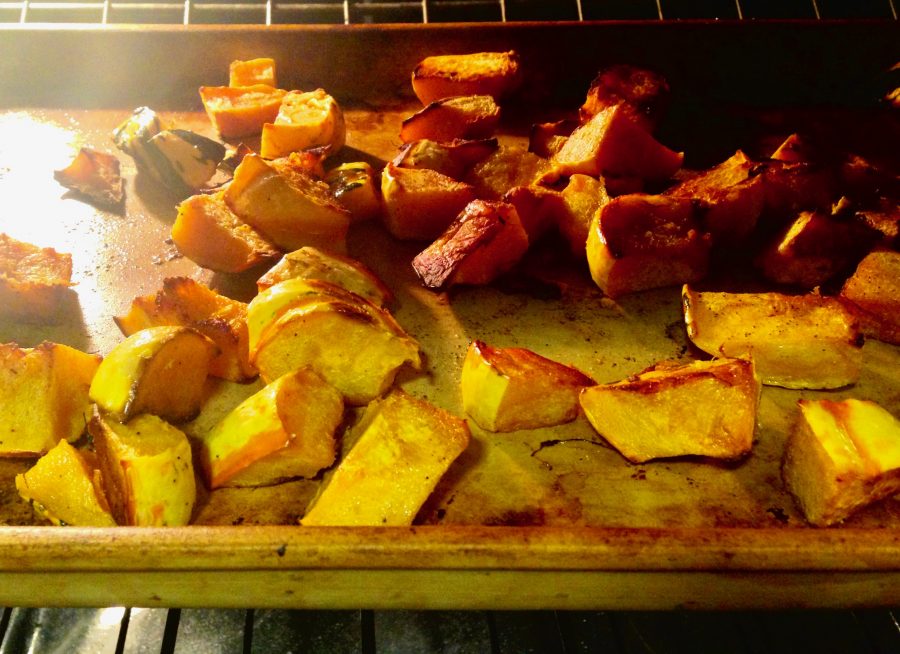
Roasted Squash Recipe #2
Use this technique for cubed (or otherwise small shaped chunks) to serve as a side dish. Delicata (and friends) need not be peeled due their edible skin, but if you use this technique with pumpkin or butternut, peel first. Cube into one-inch or smaller chunks or slice into ¼-inch thick rounds – the smaller they are, the faster they cook. Toss with a heat-stable oil such as grapeseed, camellia seed oil, or organic canola and seasonings of choice (basic salt and pepper’s quite nice). Roast at 420°F, tossing occasionally, until golden on the outside and fork-tender. This is a great winter side dish.
Roasted Squash & Autumn Vegetable Medley
If you’d prefer a more mixed roast veggie medley, you can roast them up with chopped onions, potatoes, Brussels sprouts, beets, carrots, parsnips, etc. Just keep in mind that they all cook at different rates. Leave the squash, Brussels and onions (which cook quickly) a tad larger cube size and slower-cooking beets, carrots, and parsnips on the smaller side. And make sure everyone has enough breathing space on the sheet pan that they roast to yummy golden crispness instead of steamed mush. Roast at 350 to 375°F.
Butternut Squash ~ Good Ol’ Classic
Good ol’ butternut squash. It’s ubiquitous for good reason. The flesh tastes great, it’s smooth and easy to peel (at least as peeling squash goes), and it holds its flavor for months longer than our more unique squashes like kuri and delicata, which turn flavorless and mealy by the end of November. It’s also one of the easiest and most pest-resistant squashes to grow.
Butternut can be sliced half and roasted or peeled and cubed for recipe. The flavor and texture lies in between the kuri and delicata groups, making it quite versatile. At Thanksgiving, it’s our job to bring the squash (and make the mashed potatoes, but that’s for another blog post at another time). I appreciate the opportunity to bring a colorful, healthy vegetable to a table full of meat and simpler starches, but I must admit that my secret ingredient is lots of butter… as well as beaters and fresh-from-the-farm squash. I save all the seeds to roast for snacks.
Whipped Butternut Squash Recipe
Simmer peeled, cubed squash in water until fork tender. Drain, add a stick of butter for every one or two whole squash, cover to partly melt. Beat vigorously with a hand mixer. Add quite a bit of salt to taste, plus a little black pepper (no sugar!!). If desired, add a little whole milk, heavy cream, or half and half. This keeps nicely in a warm crock pot for several hours and also makes for great leftovers.
Butternut Squash and Sausage Soup with Crispy Sage Recipe
There’s just something about fried sage leaves, and even more so when combined with squash — it’s always a show-stopping combo! This recipe is inspired by The Instant Pot Electric Pressure Cooker Cookbook: Easy Recipes for Fast & Healthy Meals by Laurel Randolph (which is indeed full of surprisingly yummy and simple IP recipes), though it’s also easily adapted to the stove top (without adding that much extra time).
- 2 tablespoons olive oil
- Handful of fresh sage leaves
- 6 to 10 ounces of spicy Italian pork or chicken sausage (remove from casing or chop finely)
- 1 medium onion, choppe
- 2 celery sticks, chopped
- 2 garlic cloves, minced
- 1 medium butternut squash, cubed
- 2 cups chicken broth (or water)
- Salt and black pepper to taste
- 1/2 cup heavy cream or half-and-half (optional)
- Pinch of nutmeg
Fry sage leaves in oil, remove and set aside. Then brown sausage, remove from pot and set aside. (Important! Don’t leave the sausage in the pot with the forthcoming ingredients because it will make it hard to puree properly.) If needed, add a tad more oil to the pot. Sauté the onion for a minute, then the celery and garlic until fragrant. Add the squash and broth. (If using the IP, Randolph recommends adding 1/2 teaspoon baking soda to “magically brown” the squash in the pot to give more flavor. Cook on high pressure for 15 minutes, then quick release; or for the stovetop…) Simmer until everything is well cooked. Using an immersion blender, puree the vegetables to a creamy consistency. Stir in the sausage. Cream (if using) can be added here to taste, or you can leave it out as an optional addition in the bowl. Serve and top with a few sage leaves. This keeps and reheats well in the fridge and is a cafe-worthy autumn lunch served alongside autumn apple salad with fire cider maple mustard dressing.
Cheesy Squash Casserole Recipe
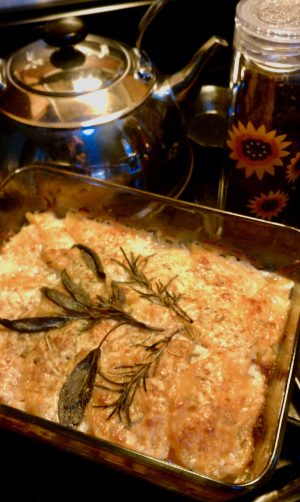 This delicious dish is a big hit at potlucks and autumn dinner gatherings, especially for dairy-loving vegetarians and gluten-free folk (because hummus with veggie sticks and kale salad can only fill you up so much). It’s absolutely delicius! It’s inspired by a Pumpkin Swiss Gratin recipe I found online, but I’ve swapped the pumpkin for butternut and Swiss for mozzarella. You can prep and freeze to thaw and bake later, too.
This delicious dish is a big hit at potlucks and autumn dinner gatherings, especially for dairy-loving vegetarians and gluten-free folk (because hummus with veggie sticks and kale salad can only fill you up so much). It’s absolutely delicius! It’s inspired by a Pumpkin Swiss Gratin recipe I found online, but I’ve swapped the pumpkin for butternut and Swiss for mozzarella. You can prep and freeze to thaw and bake later, too.
Preheat the oven to 400°F. Peel, de-seed and slice butternut squash into long 1/4-inch thick strips. Mix together 1 cup grated mozzarella, 1/2 cup Parmesan and/or Romano cheese, 1 teaspoon salt, 1/2 teaspoon ground black pepper, and 1 teaspoon dried rosemary (or 2 teaspoons fresh). Lightly grease a large casserole dish with butter. Put down one layer of squash. Cover with a handful or two of cheese mix. Repeat the layers with cheese on top. Pour over 1 cup of heavy cream (you can get by with half-and-half but not regular milk, which will curdle). Decorate with sprigs of rosemary and/or sage. Cover lightly with tin foil and bake for 30 to 40 minutes, or until the squash is tender. Remove foil and let the cheese bubble and brown. Serve warm.
Toasted Squash Seeds Recipe
Don’t throw the seeds away! All winter squash and pumpkin seeds can be toasted, but delicatas may well be the best of the squash seeds. Small, plump, tender, and delicious. They’re the perfect yummy, healthy snack or appetizer. I often enjoy them alongside dehydrated apple chips.
Rinse off the seeds in a strainer. Pull off any big chunks of pulp, but you don’t need to be obsessive about it. Put them in a single layer on a small baking sheet (I like to make mine in the toaster). No oil! Sprinkle with salt, pepper, and anything else you’d like (rosemary, cayenne, Cajun seasoning…). Bake at approximately 350°F, flipping occasionally, until they are golden and begin to pop (15-20 minutes). They seem to be easier/faster to cook in a toaster oven, but you can play around with a regular oven, too. These don’t last long in our house, but if you find yourself with a surplus, they last for weeks to months in an air-tight container in the pantry.
Fresh & Local Matters
Enjoy your winter squash now while they’re fresh from the farm and at their prime! In my experience, kuri and kabocha really need to be purchased directly at the farm stand because store-bought (if it’s coming from non-local sources) totally lacks in flavor. Both kuri/kabocha and delicata/friends taste best in October and will get mealy and less flavorful by the end of November. Sure, delicata will look great long into winter, but it doesn’t taste anywhere near as good. Butternut’s far more forgiving in storage, but they do typically taste far better from a local farm than who-knows-where at the grocery store.
Enjoy, and happy autumn!
Clinical herbalist Maria Noël Groves sees clients and teaches classes at Wintergreen Botanicals Herbal Clinic & Education Center in Allenstown, New Hampshire.
The statements made on this blog have not been evaluated by the FDA and are not intended to diagnose, prescribe, recommend, or offer medical advice. Please see your health care practitioner for help regarding choices and to avoid herb-drug interactions.
Variations on this blog originally appeared on the Concord Food Co-op site. It has been adapted and reprinted with permission.


